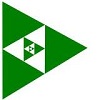
PART 3: Successful partnership was built on shared interests, mutual trust

(EDITOR’S NOTE: This is the final article in a three-part series exploring a successful university-private partnership that recently won a major National Science Foundation grant.)
By Tom Ballard, Director of Innovation and Entrepreneurial Initiatives, Pershing Yoakley & Associates, P.C.
Successful partnerships occur when individuals have shared interests and mutual trust.
These two characteristics underscore the collaboration between the University of Tennessee (UT) and Nanomechanics, Inc. that produced a successful $2.2 million grant from the National Science Foundation (NSF). The official title of the five-year project is “Development of and Broad-Based Materials Research with the Next Generation Nanomechanical Testing Laboratory.”
The partnership was clearly enabled by a three-decade friendship and research collaboration between Warren Oliver, Co-Founder of Nanomechanics, and George Pharr, Director of the Joint Institute for Advanced Materials (JIAMS). The latter is itself a collaboration between UT and Oak Ridge National Laboratory.
When UT needed a commercial partner for its NSF proposal team, Pharr naturally looked to Nanomechanics. For the latter, it was an opportunity to turn a lemon into lemonade.
“We had prepared a really significant Phase II proposal,” John Swindeman, Nanomechanics’ Chief Executive Officer, said. The proposal built on a Phase I Small Business Innovation Research (SBIR) award that Nanomechanics had to develop a high temperature indentation capability for the U.S. Air Force.
“We were really discouraged not to get it funded,” he said. When Oliver learned of the UT proposal opportunity, it presented Nanomechanics an opportunity to be part of an effort to continue the SBIR work with a different customer.
“Our proposal evolved and changed,” Swindeman said. As noted in the first article in the series, the initial proposal to NSF was rejected. The team was undeterred.
“Let’s take our learnings, modify the proposal, and have another go,” Swindeman said of the decision made in December 2013.
The second effort was successful, although the NSF reviewers said, “We don’t think it is possible” to do what the team proposed.
Such words are powerful stimulants for researchers and technologists!
“Our responsibility is to develop the instrumentation to allow each of the scientific tracks to succeed,” Swindeman explained, adding that only one of those tracks is currently funded.
Nanomechanics will deliver the initial instrument system by the end of the first year, deliver a system “with all the bells and whistles” by the end of the second year, and consult with UT the next three years on use of the instrument and optimization of its algorithms.
“We see value in commercialization of the technology,” Swindeman said. “It allows people to study super alloys in ways not previously possible.”
For Nanomechanics, the NSF work underscores significant progress for the small company. Until recently, it was heavily tied to one customer that accounted for 80 percent of its revenues. Today, it has multiple customers with the largest accounting for just 30 percent of its revenues.
“We now have a worldwide distribution system and just enjoyed a record year for orders,” Swindeman added.
As far as the NSF grant, he offers a significant observation that should be noted.
“It shows how the entrepreneurial community can work with UT,” Swindeman says.


